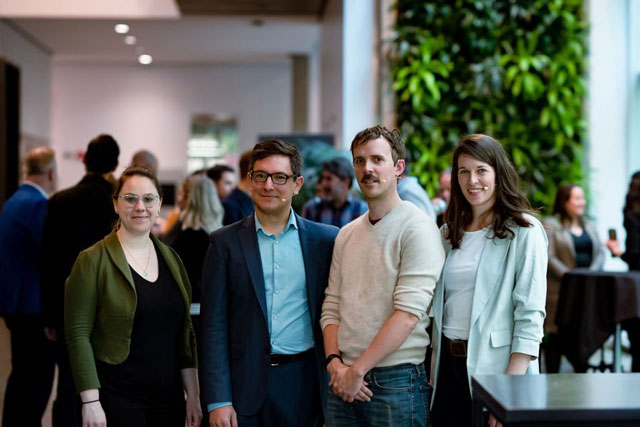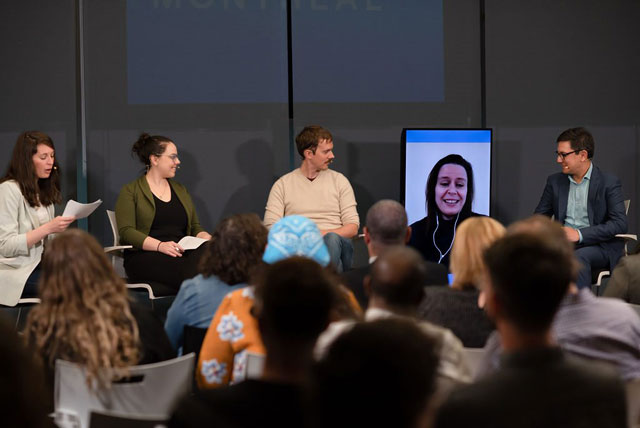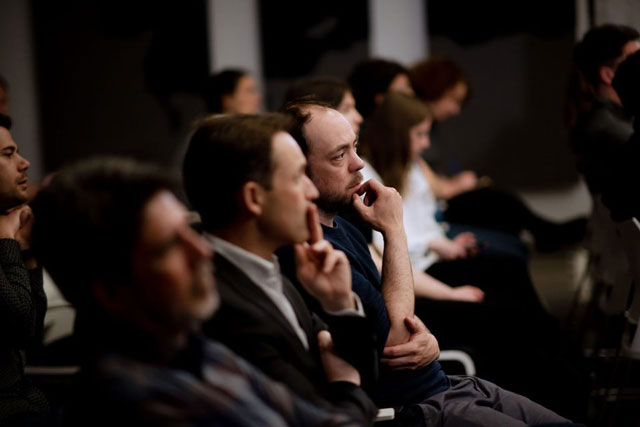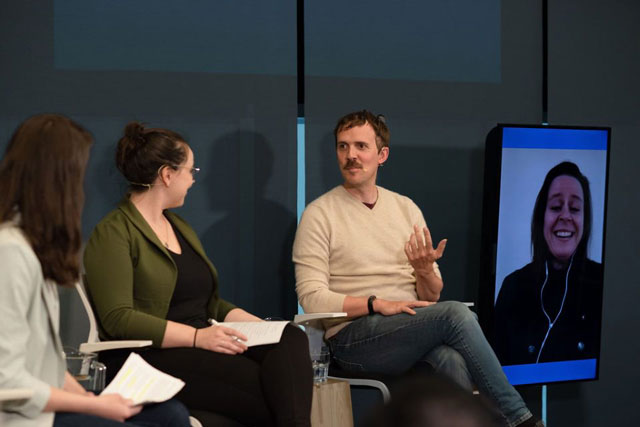How can we make montréal an accessible city by 2030? – panel of experts
The Agence’s vision of Montréal’s future is of a city that’s accessible to everyone. When it comes to making this vision a reality by 2030, what factors are driving or impeding the transition?
To determine what needs to be done to make this happen, the Agence brought together a panel of experts with various areas of expertise. Moderated by Gabrielle Lamontagne-Hallé, the panel included:
- Sandrine Cabana-Degani – Executive Director, Piétons Québec
- Pierre-Étienne Gendron-Landry – Executive Director, Société Logique
- Amélie-Myriam Plante – Land-Use Planner, Anthropole
- Juan Torres, Ph.D. – Full Professor, Université de Montréal’s School of Urban Planning and Landscape Architecture
AN ACCESSIBLE CITY?
Not everyone experiences the city the same way, and there are numerous issues to consider when it comes to making it more accessible.
For Pierre-Étienne Gendron-Landry, a universally accessible city is one where everyone can move through public spaces independently, regardless of their physical, cognitive or perceptual ability. There are many factors that can influence a citizen’s journey through public spaces, including their age, income and gender.
In an accessible city, everyone can take advantage of the resources the city has to offer. However, Juan Torres highlights an additional challenge: defining who “everyone” is. According to the urban planner, this is difficult because our needs, interests and abilities are constantly changing: “The way we see things in 2023 will be different than in 2030. A universally accessible city is a city that’s sensitive to all these emerging differences and is able to address them as quickly as possible.”
“I also see it as a continuum, a chain of movements where every link has the potential to break,” says Amélie-Myriam Plante. When a space doesn’t allow citizens to participate socially and independently, accompanied or aided by another person, or when the accessibility measures it offers go unnoticed, this chain is broken.
Comfort and safety are equally important considerations for Sandrine Cabana-Degani. In her view, not only does the population need to be able to get around using various modes of transportation (bike, foot, public transit, etc.), but these journeys also need to be made safely.

AN EVOLVING CONCEPT OF ACCESSIBILITY
For Pierre-Étienne Gendron-Landry, when it comes to mobility, our mentality and expectations are changing rapidly. “I’m oversimplifying a bit, but the focus used to be on how to travel as quickly as possible over the greatest distance possible, whereas now, we spend more time thinking about various mobility options and how everyone can access different spaces in a given area—maybe not the quickest way, but certainly the most reliable way.” In other words, if one mode of transportation is unavailable, it’s important to be able to rely on another and have a variety to choose from. He also says that the current trend is to try to put users’ concerns at the forefront of spatial planning.

WHAT BARRIERS ARE THERE TO ACCESSIBLE CITIES?
For Amélie-Myriam Plante, working in silos and failing to be cross-sectional is one of the main obstacles to accessibility initiatives. According to Plante, communication between various municipal teams that are working on developing a universal accessibility policy, development plan or MADA (Municipalité amie des aînés [Senior-Friendly Municipality]) policy is crucial to avoid "dropping the ball on certain things.”
Car culture is another factor hindering the transition, particularly for pedestrians, says Sandrine Cabana-Degani. “This car culture is reflected in regulatory and normative frameworks, which shape how our communities are built.” For example, she points to the lack of sidewalks in some areas, high traffic speeds and poor access to services.
For Pierre-Étienne Gendron-Landry, dividing users into categories with conflicting needs is a counterproductive trend. Their needs are not necessarily at odds and may be complementary, or even similar. As an example, he points to pedestrians and cyclists: cyclists can become pedestrians and vice versa.
Similarly, Amélie-Myriam Plante says that the population’s needs should be considered “from stroller to walker.” People’s physical abilities and needs don’t stay the same throughout their lives: “Parents’ needs often overlap with seniors’ needs, particularly in terms of rest areas and access to public washrooms for more frequent stops, for instance,” she points out. According to the panelists, urban planning solutions should therefore be considered jointly, with a focus on commonalities instead of conflicts.
THE ROLE OF THE CURBSIDE AND PARKING
For Sandrine Cabana-Degani, curbsides offer a wealth of urban planning opportunities that support accessibility. She points to “parklets” and five-metre clearance requirements around intersections: “Enlivening urban spaces is a way of creating a feeling of safety. If these spaces are well designed, they can improve urban residents’ mobility.”
Juan Torres adds that parklets are a good example of tactical urban planning that gives the population tools to shape the city according to its needs and take ownership of it. Since streets are public spaces and highly versatile collective resources, he explains that they shouldn’t only be considered in terms of their uses, but also of their users. What’s more, they shouldn’t only be thought of in terms of travel, but of the activities they make possible.
“Rethinking the curbside is a way of giving ourselves more leeway to create a street that can accommodate many more modes of transportation,” adds Société Logique’s executive director Pierre-Étienne Gendron-Landry. For him, prioritizing a variety of modes of transportation and diversifying the way streets are used is a way for cities to create a roadway system that is not only more versatile, but also more resilient.

URBAN PLANNING FOR ALL
Juan Torres stresses that there are many issues that must be taken into consideration for a city to be accessible, such as an aging population, ecosystem rediversification and the increasing prevalence of social media and artificial intelligence in our daily lives: “We need to be asking ourselves these questions to be aware of our blind spots and to accept that there will always be blind spots when it comes to accessibility.”
Public consultation is a tool to ensure that we’re building more inclusive cities, says Amélie Myriam Plante. “Citizens are being consulted more and more, and I think that's one of the best ways to identify blind spots.” Citizens have a lived experienced of spaces.
According to Gendron-Landry, it’s important to avoid reducing people to their functional abilities and to unlearn the binary concept of “disabled person vs. non-disabled person.” The needs of people with disabilities can also serve as an indicator of the entire population's needs, he adds. “When we make spaces accessible, it doesn’t just benefit a small percentage of the population; it benefits everyone.”

